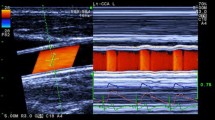Abstract
Wave intensity analysis is a method of studying intravascular flow wave propagation, calculated as the product of the rate of change in pressure (dP/t) and the rate of change in velocity (dU/dt). The typical pattern of wave intensity seen during the cardiac cycle has two dominant peaks. The larger first peak (FP) occurs during early systole when a forward traveling compression wave is generated by the left ventricle. The second smaller peak (SP) follows a period of relatively little net wave production during mid-systole. Wave reflection is seen as a small backward-traveling compression wave occurring just after the first peak of wave intensity (NP). In this study, we investigated the usefulness of parameters from the wave intensity for estimating the efficacy of the Α-1 blocker, doxazosin, to reduce blood pressure, by the reduction of peripheral vascular resistance. We examined 20 patients with essential hypertension. Patients were included if their diastolic blood pressure was ≫95 mmHg on at least three separate visits to the clinic. The study consisted of a 2-week baseline phase followed by a 2–4-week dose-adjusted phase with doxazosin. Treatment began with 1 mg/day doxazosin, and the dose was doubled fortnightly until the diastolic blood pressure was ≪90 mmHg. Blood–pressure measurements and side effects were recorded at intervals of 2 weeks. Before and after 4 weeks of stable treatment with doxazosin, a comprehensive clinical evaluation was given. Doxazosin reduced systolic and diastolic blood pressure. Both FP and SP increased and NP decreased. ΔMBP (change in mean blood pressure) correlated well with NP before and after the antihypertensive therapy. The efficacy of doxazosin was confirmed by the decreased reflection wave of aortic flow from wave intensity analysis. Thus, patients with a significant reflection wave may be good candidates for antihypertensive treatment by a vasodilator, such as doxazosin.
Similar content being viewed by others
Author information
Authors and Affiliations
Corresponding author
Rights and permissions
About this article
Cite this article
Fujimoto, S., Mizuno, R., Saito, Y. et al. Clinical application of wave intensity for the treatment of essential hypertension. Heart Vessels 19, 19–22 (2004). https://doi.org/10.1007/s00380-003-0725-9
Received:
Accepted:
Issue Date:
DOI: https://doi.org/10.1007/s00380-003-0725-9




